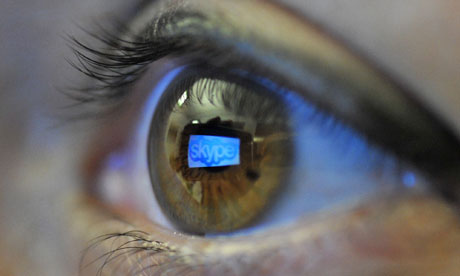From the Guardian (full article)
Skype worked to enable Prism collection of video calls. Company says it is legally compelled to comply

Skype worked with intelligence agencies last year to allow Prism to collect video and audio conversations. Photograph: Patrick Sinkel/AP
Microsoft has collaborated closely with US intelligence services to allow users' communications to be intercepted, including helping the National Security Agency to circumvent the company's own encryption, according to top-secret documents obtained by the Guardian.
The files provided by Edward Snowden illustrate the scale of co-operation between Silicon Valley and the intelligence agencies over the last three years. They also shed new light on the workings of the top-secret Prism program, which was disclosed by the Guardian and the Washington Post last month.
The documents show that:
[snip]
• In July last year, nine months after Microsoft bought Skype, the NSA boasted that a new capability had tripled the amount of Skype video calls being collected through Prism;
[snip]
Microsoft's latest marketing campaign, launched in April, emphasizes its commitment to privacy with the slogan: "Your privacy is our priority."
Similarly, Skype's privacy policy states: "Skype is committed to respecting your privacy and the confidentiality of your personal data, traffic data and communications content."
But internal NSA newsletters, marked top secret, suggest the co-operation between the intelligence community and the companies is deep and ongoing.
The latest documents come from the NSA's Special Source Operations (SSO) division, described by Snowden as the "crown jewel" of the agency. It is responsible for all programs aimed at US communications systems through corporate partnerships such as Prism.
[snip]
The NSA has devoted substantial efforts in the last two years to work with Microsoft to ensure increased access to Skype, which has an estimated 663 million global users.
One document boasts that Prism monitoring of Skype video production has roughly tripled since a new capability was added on 14 July 2012. "The audio portions of these sessions have been processed correctly all along, but without the accompanying video. Now, analysts will have the complete 'picture'," it says.
Eight months before being bought by Microsoft, Skype joined the Prism program in February 2011.
According to the NSA documents, work had begun on smoothly integrating Skype into Prism in November 2010, but it was not until 4 February 2011 that the company was served with a directive to comply signed by the attorney general.
The NSA was able to start tasking Skype communications the following day, and collection began on 6 February. "Feedback indicated that a collected Skype call was very clear and the metadata looked complete," the document stated, praising the co-operation between NSA teams and the FBI. "Collaborative teamwork was the key to the successful addition of another provider to the Prism system."
ACLU technology expert Chris Soghoian said the revelations would surprise many Skype users. "In the past, Skype made affirmative promises to users about their inability to perform wiretaps," he said. "It's hard to square Microsoft's secret collaboration with the NSA with its high-profile efforts to compete on privacy with Google."
The information the NSA collects from Prism is routinely shared with both the FBI and CIA. A 3 August 2012 newsletter describes how the NSA has recently expanded sharing with the other two agencies.
The NSA, the entry reveals, has even automated the sharing of aspects of Prism, using software that "enables our partners to see which selectors [search terms] the National Security Agency has tasked to Prism".
The document continues: "The FBI and CIA then can request a copy of Prism collection of any selector…" As a result, the author notes: "these two activities underscore the point that Prism is a team sport!"
[snip]
